HOME
ANIMALS
SEA
LIFE
Tubeworms
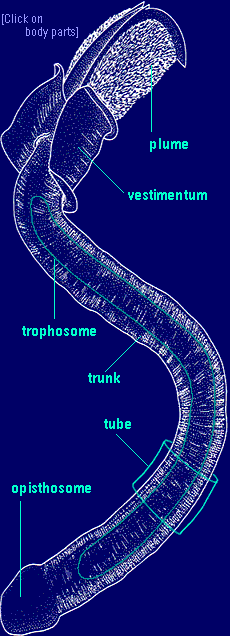 Tubeworms
are animals, just as you and I are, yet they have no mouth, no
stomach, no intestine, and no way to eliminate waste. How do they
live? A creature so unusual that biologists initially placed it in
its own special class in the animal kingdom, the vestimentiferans.
Tubeworms
are animals, just as you and I are, yet they have no mouth, no
stomach, no intestine, and no way to eliminate waste. How do they
live? A creature so unusual that biologists initially placed it in
its own special class in the animal kingdom, the vestimentiferans.
Anatomy
Plume
 This
soft, bright-red structure serves the same purpose as a mouth would
if the tubeworm had one. It sucks in the ingredients that the
microbes living in the worm's body will use to fashion its food.
These three ingredients -- oxygen and carbon dioxide in seawater and
hydrogen sulfide in the superheated water erupting from the vent or
black smoker -- tend to react violently when they come into contact
with each other. Yet using special hemoglobins in its blood-rich
plume (hence the red color), the tubeworm has found a way to
transport the ingredients in its blood without this reaction taking
place -- and without the toxic hydrogen sulfide poisoning it, as it
would you or me.
This
soft, bright-red structure serves the same purpose as a mouth would
if the tubeworm had one. It sucks in the ingredients that the
microbes living in the worm's body will use to fashion its food.
These three ingredients -- oxygen and carbon dioxide in seawater and
hydrogen sulfide in the superheated water erupting from the vent or
black smoker -- tend to react violently when they come into contact
with each other. Yet using special hemoglobins in its blood-rich
plume (hence the red color), the tubeworm has found a way to
transport the ingredients in its blood without this reaction taking
place -- and without the toxic hydrogen sulfide poisoning it, as it
would you or me.
Vestimentum
Though it may not look like
much, this part of the worm is like Mission Control. A muscular
structure, it helps to anchor the upper portion of the worm in the
tube. It provides safe passage for the blood heading from the plume
to the trophosome. It generates new tube material. It holds the
reproductive pores from which the worm releases sperm or eggs during
spawning. Finally, along with various glands, this structure harbors
simplified versions of the two organs that most closely bind this
primitive creature to its fellow animals: the heart and the brain.
Trophosome
Here, the microbes that live
symbiotically in the worm make their home in special cells. (Quite a
few microbes live here: an estimated 285 billion bacteria per ounce
of tissue.) In exchange for a safe, cozy place to live, they give the
worm all the food it needs. They do this by absorbing those three
ingredients pumped down from the plume -- oxygen, carbon dioxide, and
hydrogen sulfide -- and then controlling their reaction. In essence,
the microbes use the chemical energy released from the oxidation of
sulfide into sulfate to fix carbon dioxide into the organic carbon
that nourishes both the microbes and the worm. It's a good deal for
both creatures -- until, that is, the tubeworm decides to digest a
few microbes.
Trunk
Imagine having no anus. Waste
would have nowhere to go, right? Well, that's the case with the
tubeworm. It has no anus, and so the sulfate left over after the
microbes have done their business is simply stored in the animal's
body. Since giant tubeworms can live several decades, you can imagine
quite a heap of this stuff building up in their tissues. Yet it is
not this waste material but sulfide in the worm's bloodstream that
gives the animal its powerful rotten-egg stench. Biologists
dissecting tubeworms brought up from the deep say it's one of the
nastiest smells you'd ever want to smell.
Tube
This hard cylinder, which
varies in thickness , is basically like the shell of a lobster or
crab. It grows as the worm grows, providing a safe home for the
animal. The delicate plume, which is the tubeworm's only exposed
part, can be retracted into the tube at a moment's notice.
Opisthosome
Like the vestimentum, the
opisthosome produces new tube material and helps anchor the worm in
its tube, which is often planted deep within the crevices of a black
smoker. Giant tubeworms can reach well over a yard long, and the
temperatures they have to cope with over that length boggle the mind.
Imagine having your head in near-freezing water and your foot planted
in scalding rock. That's what tubeworms have to deal with: biologists
have measured temperatures at a worm's plume of 35°F while that
at its base is 86°F.
Habitat
If there is a harsher place
to live than a hydrothermal vent, it hasn't been found yet. Pitch
darkness, poison gas, heavy metals, extreme acidity, enormous
pressure, water at turns freezing and boiling. Yet amazing
communities of life exist at hydrothermal vents and the so-called
"black smoker" chimneys that, given the right conditions,
rise above them like erupting stalagmites. Blind shrimp, giant white
crabs, and a variety of tubeworms are just some of the more than 300
species of vent life that biologists have identified since scientists
first blundered upon this otherworldly community two decades ago.
More than 95 percent of these species are new to science.
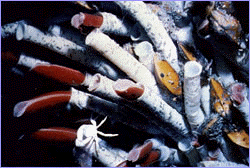
It's hard to say which is
more remarkable to scientists studying this bizarre world thousands
of feet beneath the sea: what these animals have to cope with, or
what they have come up with to do that coping.
For starters, it's pitch
black at such depths. Sunlight penetrates no farther than a few
hundred feet down, leaving the deep-sea floor as dark as the deepest
cave. With no sunlight, there are no plants; all vent life belongs to
the animal kingdom. And with no plants, there is no photosynthesis.
Biologists were flabbergasted when they first learned that creatures
lived in total darkness at the seafloor. All other life ever
identified, on land or in the sea, derives its energy either directly
or indirectly from the sun. How, they wondered, did these animals
manage without?
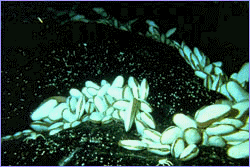 Through
chemosynthesis, it turns out. Vent species rely not on photons from
the sun but on chemicals from the Earth's interior. Tiny microbes
oxidize the hydrogen sulfide that diffuses out of the vents,
providing nutrients for animals higher up the food chain. Some
creatures, such as the mollusks known as gastropod snails, feast on
the bacteria directly; others, including predatory fish, dine on
animals that have eaten or otherwise made use of the microbes; still
others, like tubeworms, host the microorganisms in their tissues in
exchange for organic compounds that the bacteria fashion from the
vent chemicals and seawater. (The only element from above that these
microbes require for their artistry is oxygen, which is abundant in
seawater and was originally produced, of course, by plants.
Through
chemosynthesis, it turns out. Vent species rely not on photons from
the sun but on chemicals from the Earth's interior. Tiny microbes
oxidize the hydrogen sulfide that diffuses out of the vents,
providing nutrients for animals higher up the food chain. Some
creatures, such as the mollusks known as gastropod snails, feast on
the bacteria directly; others, including predatory fish, dine on
animals that have eaten or otherwise made use of the microbes; still
others, like tubeworms, host the microorganisms in their tissues in
exchange for organic compounds that the bacteria fashion from the
vent chemicals and seawater. (The only element from above that these
microbes require for their artistry is oxygen, which is abundant in
seawater and was originally produced, of course, by plants.
Temperature of
this Juan de Fuca Smoker: 648°F.
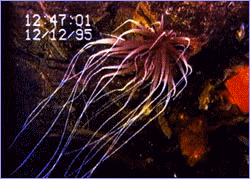
As if utter darkness were not
enough, vent animals must contend with a witch's cauldron of deadly
toxicants. Foremost among them is hydrogen sulfide, one of the
principal ingredients of the broiling water spewing from vents and
black smokers. While vent microbes thrive on the stuff, this gas is
lethal to most other organisms, including the creatures that live
nearby. Yet not only do those animals survive it, they depend on it
as intrinsically as they do on the microbes. Hydrogen sulfide reacts
spontaneously with oxygen, so as soon as vent fluids come into
contact with seawater, a swift reaction occurs, releasing energy. All
that energy would go to waste if it were it not for the microbes.
They harness that reaction and use carbon dioxide to make organic
compounds that tubeworms need to live.
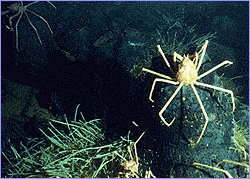 Vents
and smokers also release a bevy of heavy metals. Besides being toxic
substances, these particles can clog mouthparts and gills. Biologists
are still trying to figure out exactly how vent animals cope with
these. Several animals have metal-binding proteins in their systems,
while others, like some polychaete tubeworms, appear to expel these
toxics in mucus. Beyond the toxic gas and particles, vent water can
also be extremely acidic. The pH of waters coming out of black
smokers can be as low as 2.8, making it more acidic than vinegar.
Biologists have seen "naked" snails around hydrothermal
vents that could not form their calcium carbonate shells because the
water was too acidic.
Vents
and smokers also release a bevy of heavy metals. Besides being toxic
substances, these particles can clog mouthparts and gills. Biologists
are still trying to figure out exactly how vent animals cope with
these. Several animals have metal-binding proteins in their systems,
while others, like some polychaete tubeworms, appear to expel these
toxics in mucus. Beyond the toxic gas and particles, vent water can
also be extremely acidic. The pH of waters coming out of black
smokers can be as low as 2.8, making it more acidic than vinegar.
Biologists have seen "naked" snails around hydrothermal
vents that could not form their calcium carbonate shells because the
water was too acidic.
Pressure's on
Another factor these
creatures have evolved to live with is the pressure. With every 32.8
feet of descent, the weight of the water above increases by 14.7
pounds per square inch. At 7,500 feet, which is the depth of some
black smokers, the pressure animals feel over every square inch of
their bodies is over 3,350 pounds. At such pressures, any air
pockets, such as lungs, would be crushed flat as a deflated balloon.
Vent animals have evolved bodies with no such air spaces.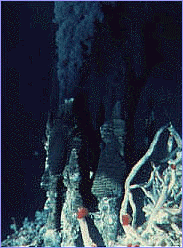
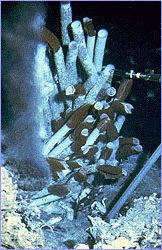 Fire
and ice
Fire
and ice
Perhaps the most
startling condition these animals cope with is unusual temperatures.
For they must deal with both extremes -- icy and scalding, often
simultaneously. Water at the bottom of the ocean is about 35°F,
while vent fluids released from chimneys can reach 750°F.
Tubeworms and other vent creatures often live right on the flanks of
black smokers, within mere inches of the scorching brew, which only
the pressure keeps from boiling. Currents constantly stir up the hot
and cold, meaning tubeworms and the like have to deal with ever
changing temperatures. Even without currents, the extremes are
sobering. Biologists have determined that the difference in
temperature between a tubeworm's plumed tip and its base anchored in
the side of a vent can be more than 50°F. Vent microbes
themselves can take temperatures up to 230°F.
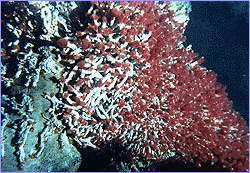 Location,
location, location
Location,
location, location
To compound problems,
the physical environment of the vent itself has limitations.
Surprisingly enough considering the vastness of the ocean floor,
space is extremely limited. Talk about location: a tubeworm, for one,
must live close enough to a vent to get hydrogen sulfide but not
close enough to get burned. To make matters worse, due to geophysical
changes taking place beneath them, hydrothermal vents and black
smokers can turn off suddenly, choking off the life that depended on
them. Even healthy black smokers, though they're made of stone, are
fragile structures that eventually crumble beneath their own weight.
So vent creatures have to have a means for detecting, traveling to,
and colonizing new habitat. Yet vents are spread far and wide
throughout the world's seas. How newborn vents acquire new residents
is a mystery.
But clearly vent creatures
manage to do it. Biologists have discovered these animals at sites
right around the mid-ocean ridge that circles the globe. Indeed, they
have found that vent animals more closely resemble vent creatures on
the other side of the planet than they do animals living even a few
feet away from them on the ocean floor.
Did life
begin at hydrothermal vents?
The irony of vent communities
is that, despite the harshness of their home, they appear to have
survived for many millions of years, having apparently changed little
in that time. Vent life, for one thing, appears to be more closely
related to ancient animals than anything alive today. What's more,
even during the periodic mass extinctions that have swept the Earth,
vent creatures have calmly gone about their lives, probably little
affected. This tenacity, evinced albeit through the most exceptional
isolation, bodes well for them in the current mass extinction event.
Some biologists have gone so
far as to suggest that a vent-like environment was the place where
life on Earth likely got its start. And if such a miracle could have
occurred here on Earth, why not on other planets that have the
necessary ingredients, including heat, water, and the right mix of
chemicals? In the end, there may indeed be a harsher place to live
than hydrothermal vents. But again, it has never been found.
Peter Tyson is
Online Producer of NOVA.
 Tubeworms
are animals, just as you and I are, yet they have no mouth, no
stomach, no intestine, and no way to eliminate waste. How do they
live? A creature so unusual that biologists initially placed it in
its own special class in the animal kingdom, the vestimentiferans.
Tubeworms
are animals, just as you and I are, yet they have no mouth, no
stomach, no intestine, and no way to eliminate waste. How do they
live? A creature so unusual that biologists initially placed it in
its own special class in the animal kingdom, the vestimentiferans. This
soft, bright-red structure serves the same purpose as a mouth would
if the tubeworm had one. It sucks in the ingredients that the
microbes living in the worm's body will use to fashion its food.
These three ingredients -- oxygen and carbon dioxide in seawater and
hydrogen sulfide in the superheated water erupting from the vent or
black smoker -- tend to react violently when they come into contact
with each other. Yet using special hemoglobins in its blood-rich
plume (hence the red color), the tubeworm has found a way to
transport the ingredients in its blood without this reaction taking
place -- and without the toxic hydrogen sulfide poisoning it, as it
would you or me.
This
soft, bright-red structure serves the same purpose as a mouth would
if the tubeworm had one. It sucks in the ingredients that the
microbes living in the worm's body will use to fashion its food.
These three ingredients -- oxygen and carbon dioxide in seawater and
hydrogen sulfide in the superheated water erupting from the vent or
black smoker -- tend to react violently when they come into contact
with each other. Yet using special hemoglobins in its blood-rich
plume (hence the red color), the tubeworm has found a way to
transport the ingredients in its blood without this reaction taking
place -- and without the toxic hydrogen sulfide poisoning it, as it
would you or me.
 Through
chemosynthesis, it turns out. Vent species rely not on photons from
the sun but on chemicals from the Earth's interior. Tiny microbes
oxidize the hydrogen sulfide that diffuses out of the vents,
providing nutrients for animals higher up the food chain. Some
creatures, such as the mollusks known as gastropod snails, feast on
the bacteria directly; others, including predatory fish, dine on
animals that have eaten or otherwise made use of the microbes; still
others, like tubeworms, host the microorganisms in their tissues in
exchange for organic compounds that the bacteria fashion from the
vent chemicals and seawater. (The only element from above that these
microbes require for their artistry is oxygen, which is abundant in
seawater and was originally produced, of course, by plants.
Through
chemosynthesis, it turns out. Vent species rely not on photons from
the sun but on chemicals from the Earth's interior. Tiny microbes
oxidize the hydrogen sulfide that diffuses out of the vents,
providing nutrients for animals higher up the food chain. Some
creatures, such as the mollusks known as gastropod snails, feast on
the bacteria directly; others, including predatory fish, dine on
animals that have eaten or otherwise made use of the microbes; still
others, like tubeworms, host the microorganisms in their tissues in
exchange for organic compounds that the bacteria fashion from the
vent chemicals and seawater. (The only element from above that these
microbes require for their artistry is oxygen, which is abundant in
seawater and was originally produced, of course, by plants.

 Vents
and smokers also release a bevy of heavy metals. Besides being toxic
substances, these particles can clog mouthparts and gills. Biologists
are still trying to figure out exactly how vent animals cope with
these. Several animals have metal-binding proteins in their systems,
while others, like some polychaete tubeworms, appear to expel these
toxics in mucus. Beyond the toxic gas and particles, vent water can
also be extremely acidic. The pH of waters coming out of black
smokers can be as low as 2.8, making it more acidic than vinegar.
Biologists have seen "naked" snails around hydrothermal
vents that could not form their calcium carbonate shells because the
water was too acidic.
Vents
and smokers also release a bevy of heavy metals. Besides being toxic
substances, these particles can clog mouthparts and gills. Biologists
are still trying to figure out exactly how vent animals cope with
these. Several animals have metal-binding proteins in their systems,
while others, like some polychaete tubeworms, appear to expel these
toxics in mucus. Beyond the toxic gas and particles, vent water can
also be extremely acidic. The pH of waters coming out of black
smokers can be as low as 2.8, making it more acidic than vinegar.
Biologists have seen "naked" snails around hydrothermal
vents that could not form their calcium carbonate shells because the
water was too acidic.
 Fire
and ice
Fire
and ice Location,
location, location
Location,
location, location